STK Pro, STK Premium (Air), STK Premium (Space), or STK Enterprise
You can obtain the necessary licenses for this tutorial by contacting AGI Support at support@agi.com or 1-800-924-7244.
The results of the tutorial may vary depending on the user settings and data enabled (online operations, terrain server, dynamic Earth data, etc.). It is acceptable to have different results.
Capabilities covered
This lesson covers the following STK Capabilities:
- STK Pro
- Communications
What you will learn
This walkthrough introduces you to some of the 2D and 3D graphics capabilities available with STK's Communications capability. In this exercise, you will:
- Define and display contours of antenna gain and other RF characteristics in the 2D and 3D Graphics windows
- Use vectors to enhance the 3D Graphics window display of a transmitter on a GEO satellite
- Create and vary 3D Graphics window representations of antenna beam patterns
Video guidance
Watch the following video. Then follow the steps below, which incorporate the systems and missions you work on (sample inputs provided).
Creating a scenario
Start by creating a scenario.
- Create a scenario and name it "CommGraphics".
- Set the Start time to 1 Jul 2016 18:00:00.000 UTCG.
- Set the Stop time to 2 Jul 2016 18:00:00.000 UTCG.
Save often!
Adding a satellite
For the communications satellite, use the Orbit Wizard to create a geosynchronous satellite.
- Using the Insert STK Objects tool, insert a Satellite object using the Orbit Wizard method.
- When the Orbit Wizard window appears, make the following changes:
- Click .
| Option | Value |
|---|---|
| Type | Geosynchronous |
| Satellite | CommSat |
Adding a receiver
- Using the Insert STK Objects tool, insert a Receiver (
 ) object using the Insert Default method.
) object using the Insert Default method. - When the Select Object window appears, select CommSat and then click .
- In the Object Browser, rename the Receiver object to "CommRcvr."
- Open CommRcvr's (
 ) properties (
) properties ( ).
). - On the Basic - Definition page, change Type to Complex Receiver Model.
- Click .
- Select the Antenna tab. You can see that the Main-lobe Gain is approximately ~ 41 dB.
The default antenna for a Complex Receiver Model is Gaussian. The satellite that the antenna is attached to is in a Geosynchronous orbit. The orientation of the antenna is azimuth = 0 degrees and elevation = 90 degrees. Therefore, the main-lobe gain is directed along the Satellite object's Z body axis, which is pointing toward nadir.
Showing receiver communication contours
- Go to CommRcvr's (
 ) 2D Graphics - Contours properties page.
) 2D Graphics - Contours properties page. - Select the Show Contour Graphics check box.
- Clear the Relative To Maximum check box.
- In the Level Adding field, change Add Method to Explicit.
- Change the Level value to 41, which is the approximate maximum gain for this antenna in dB.
- Click , which adds the Level value to the Level Attributes field.
- Repeat steps 4 and 5 to add the following gain levels to the Level Attributes field: 30, 20, 10, 0, -10, and -20.
- In the Level Labels section, select the Show check box and set Number of Decimal Digits to 0.
- Ensure Color Method is set to Color Ramp.
- Set Start Color to Red and Stop Color to Blue.
- Click .
Viewing the contours
You can view the contour graphics in the 2D Graphics window.
- Bring the 2D Graphics window to the front.
- Mouse around in the 2D Graphics window to view the contours.
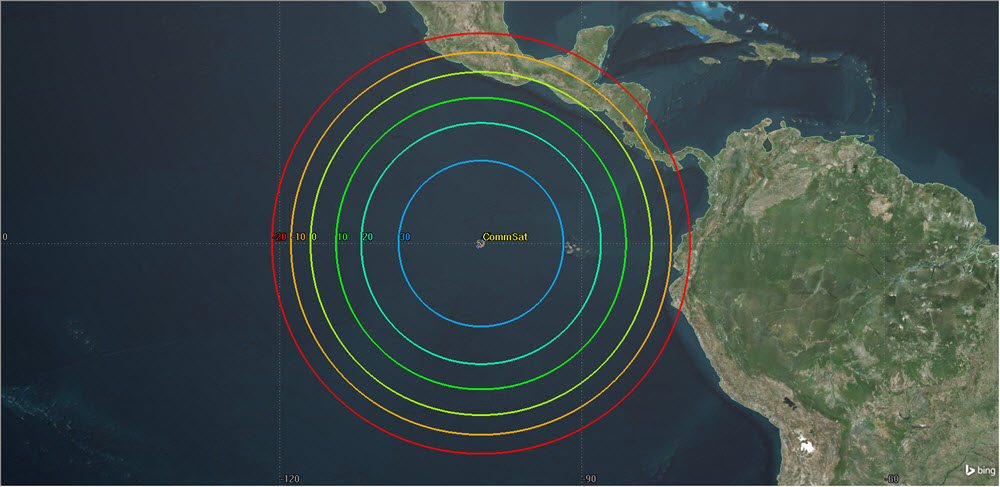
Receiver Contours
Using this method, each contour is the actual main-lobe gain value of the receiver's antenna.
Saving time and effort
There are two options on the 2D Graphics - Contours properties page that you can use to simplify and speed up the generation of gain contours:
- Use the Relative to Maximum option to have STK retrieve the antenna's maximum gain value instead of looking up the maximum gain value on the Antenna tab of the Basic - Definition page.
- For Add Method, select Start, Stop, Step instead of manually entering each gain level.
Run through the "Showing contours" process again using these convenient options.
- Return to CommRcvr's (
 ) properties and select the 2D Graphics - Contours page.
) properties and select the 2D Graphics - Contours page. - Select the Relative To Maximum check box.
- In the Level Attributes section, click .
- In the Level Attributes field, make the following changes:
- Click .
- Click .
- Return to the 2D Graphics window to view the new contours. They should look the same as the previous ones.
| Option | Value |
|---|---|
| Add Method | Start, Stop, Step |
| Start | 0 |
| Stop | -60 |
| Step | -10 |
A Start value of 0 relative to maximum is equivalent to the maximum gain value, i.e., approximately 41 dB. A value of -10 is 10 dB less than the maximum.
On your own
Before leaving receiver antenna gain contours, try some other options that are provided on the Contours page. After each change, click on the Contours page and return to the 2D Graphics window to see the results.
- Change the Add Method to Explicit and add a new level of -35 dB to the Level list.
- For one or more entries from the Level list, click the Line Style field next to it and change the style to something else (dotted, dashed, etc.).
- Change the Line Width for all gain levels to a different thickness.
- Select the Show at Altitude check box and enter an Altitude value of 5000 km. Instead of representing gain levels where the antenna beam intersects the Earth’s surface (the normal case), the contour pattern now represents gain levels where the beam crosses the selected altitude. When you reset the 2D Graphics window, the contour pattern will noticeably contract.
- After viewing the different contours, clear the Show Contour Graphics.
- Click .
Line Style settings apply only to individual levels.
Line Width settings always apply to all contour levels in the pattern.
Receiver object contour graphics are available only for Antenna Gain.
Adding a multibeam transmitter
- Using the Insert STK Objects tool, insert a Transmitter (
 ) object using the Insert Default method.
) object using the Insert Default method. - When the Select Object window appears, select CommSat (
 ) and then click .
) and then click . - In the Object Browser, rename the Transmitter object to "MultibeamXmtr".
- Open MultibeamXmtr's (
 ) properties (
) properties ( ).
). - On the Basic - Definition page, change Type to Multibeam Transmitter Model.
- In the Beams tab, click twice to insert two more beams.
- Click .
Reorienting the beams
- Using the Ctrl key, select all three beams.
- Click .
- In the Antenna Beam Orientation dialog box, make the following changes to the Elevation Initial Value and the Azimuth Increment Value parameters:
- Click to close the Antenna Beam Orientation dialog box.
- Click .
| Antenna Beam Orientation | Initial Value | Increment Value |
|---|---|---|
| Elevation | 87 deg | 0 deg |
| Azimuth | 0 deg | 120 deg |
Showing transmitter communication contours
- Go to MultibeamXmtr's (
 ) 2D Graphics - Contours page.
) 2D Graphics - Contours page. - Select the Show Contour Graphics check box.
- Change Type to EIRP (Effective Isotropic Radiated Power).
- In the Level Adding field, make the following changes:
- Click .
- In the Level Labels section, select the Show check box and set Number of Decimal Digits to 0.
- Ensure Color Method is set to Color Ramp.
- Set Start Color to Red and Stop Color to Blue.
- Click .
- Return to the 2D Graphics window to view the new contours.
| Option | Value |
|---|---|
| Add Method | Start, Stop, Step |
| Start | 0 |
| Stop | -60 |
| Step | -10 |
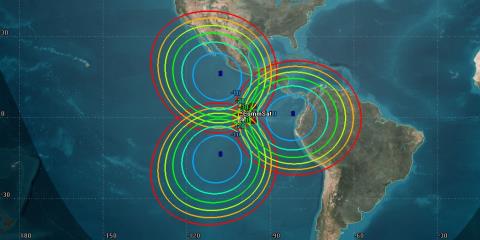
Max Gain Beams
Changing Beam Selection Strategy
The current beam selection strategy is Max Gain.
- Return to MultibeamXmtr's (
 ) properties and go to the Basic - Definition page.
) properties and go to the Basic - Definition page. - Change Beam Selection Strategy to Aggregate Active Beams.
- Click .
- Return to the 2D Graphics window to view the new contours.
This strategy combines gains to model a single beam with a gain aggregating the gains of all individual beams. STK also combines the beam powers with the respective gains to compute the aggregate EIRP for the antenna.

Aggregate Active Beams
Improving the resolution
You can improve the resolution of the contours.
- Go to MultibeamXmtr's (
 ) 2D Graphics - Contours page.
) 2D Graphics - Contours page. - Select the Set azimuth and elevation resolution together check box.
- In the Azimuth section, change the Resolution value to 0.5 deg.
- Click .
- Return to the 2D Graphics window to view the new contours.
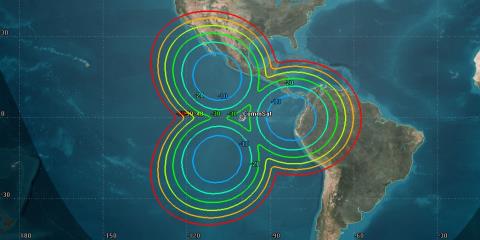
Enhanced Contours
There should be a noticeable change in the resolution of the contour graphics.
In MultibeamXmtr's (![]() ) 2D Graphics - Contours page, the Points field, immediately below the Resolution field, will automatically update to reflect the finer resolution value.
) 2D Graphics - Contours page, the Points field, immediately below the Resolution field, will automatically update to reflect the finer resolution value.
Showing contours in 3D
You can also have STK display contours in the 3D Graphics window.
- Browse to MultibeamXmtr's (
 ) 3D Graphics - Attributes page.
) 3D Graphics - Attributes page. - In the Contour Graphics section, select the Show Lines check box.
- Click .
- Select the 3D Graphics window to view the new contours.

3D Graphics Contours
Reorienting one antenna
- Return to MultibeamXmtr's (
 ) properties and go to the Basic - Definition page.
) properties and go to the Basic - Definition page. - Reset the Beam Selection Strategy to Max Gain.
- Select the Antenna tab.
- Select the Orientation subtab.
- In the Position Offset field, change the X value to 1000 km.
- Click .
- Select the 2D Graphics window to view the new contours.
- After viewing the effect of the offset on the contour graphics, return to the Position Offset field and reset the X value to zero (0) m.
- Click .
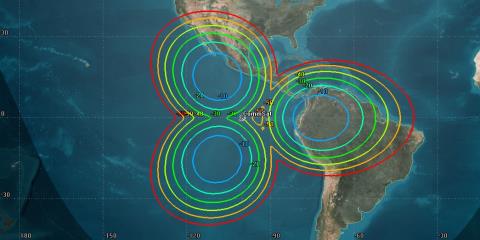
Orientation Change
In addition to EIRP, transmitter contour graphics are available for Antenna Gain, Flux Density, and RIP (Received Isotropic Power). Before moving on in the tutorial, try out one or more of the contour types using the Relative to Maximum option and the Start, Stop, Step method to avoid having to determine or guess absolute values.
Unlike Antenna Gain, which you can retrieve directly from the Antenna properties, determination of appropriate values for the other contour types requires creating additional objects, calculating access, and generating link budget reports.
Disabling the contour graphics
Clean up the 3D Graphics window of the contour graphics. This way you can continue on with creating vectors and the contour graphics won't impede your view.
- When you are finished experimenting, return to MultibeamXmtr's properties and go to the 2D Graphics - Contours page.
- Clear the Show Contour Graphics check box.
- Go to the 3D Graphics - Attributes page.
- In the Contour Graphics field, clear the Show Lines check box.
- Click .
Enhancing the 3D Graphics window display with vectors
In the following steps, you will:
- Configure the Satellite object and the Transmitter object to display body axes
- Attach the Transmitter object to a Sensor object and set the Sensor object spinning
You can then observe the display of the Satellite and Transmitter objects axes in the 3D Graphics window.
- Open CommSat's (
 ) properties and go to the 3D Graphics - Vector page.
) properties and go to the 3D Graphics - Vector page. - Select the Axes tab.
- Select the Show check box for Body Axes.
- Change the color by double-clicking the color pane. This provides a drop-down menu from which you can choose a new color.
- Click .
- In the Object Browser, right-click CommSat (
 ) and select Zoom To.
) and select Zoom To. - Select the 3D Graphics window.
- Zoom and rotate the 3D view, as necessary, to see the axes.
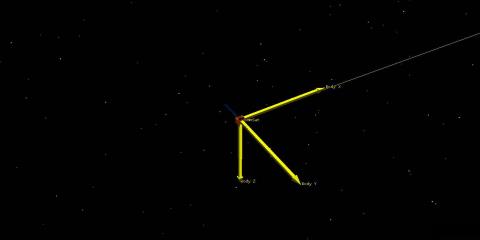
Satellite Body Axes
Adding a sensor
- Using the Insert STK Objects tool, insert a Sensor (
 ) object using the Insert Default method.
) object using the Insert Default method. - When the Select Object window appears, select CommSat (
 ) and then click .
) and then click . - In the Object Browser, rename the Sensor object to "SatSens".
- Open SatSens's (
 ) properties (
) properties ( ) and go to the Basic - Pointing page.
) and go to the Basic - Pointing page. - Change Pointing Type to Spinning.
- In the Spinning field, change the Spin Rate value to 0.2 revs/min.
- Go to the 3D Graphics - Attributes page.
- In the Lines field, select the Translucent Lines check box.
- In the Projection section, change the %Translucency value to 100.
- Click .
You are increasing the translucency so that display of the sensor cone in the 3D Graphics window does not interfere with display of the vector graphics.
Moving the transmitter
Move the transmitter from the satellite to the sensor.
- In the Object Browser, right-click MultibeamXmtr (
 ) and select Cut (
) and select Cut ( ) from the shortcut menu.
) from the shortcut menu. - Right-click SatSens (
 ) and select Paste (
) and select Paste ( ) from the shortcut menu.
) from the shortcut menu. - Expand SatSens so that you can see MultibeamXmtr.
Cut and paste is an easy way to move objects around in the scenario hierarchy. You can also use copy and paste to create duplicates of objects that you have previously created and configured. When you move or copy an object that has subobjects, STK moves or copies the subobjects along with the parent object.
Displaying the Transmitter's body axes
- Open MultibeamXmtr's (
 ) properties (
) properties ( ).
). - Go to the 3D Graphics - Vector page.
- Select the Axes tab.
- Select the Show check box for Body Axes.
- Change the color to a different color than that of the parent object's body axes.
- Click .
- Right-click CommSat (
 ) and select Zoom To.
) and select Zoom To. - Bring the 3D Graphics window to the front.

Transmitter Body Axes
Animating the scenario
Take a look at the body axes in motion.
- Using the Decrease Time Step (
 ) button in the Animation toolbar, decrease the time step to 1.0 sec.
) button in the Animation toolbar, decrease the time step to 1.0 sec. - Using the Start (
 ) button in the Animation toolbar, briefly animate the scenario to observe the transmitter body axes as they rotate with respect to the satellite body axes in the 3D Graphics window.
) button in the Animation toolbar, briefly animate the scenario to observe the transmitter body axes as they rotate with respect to the satellite body axes in the 3D Graphics window. - When you are finished, click the Reset (
 ) button in the Animation toolbar to reset the scenario back to the start time.
) button in the Animation toolbar to reset the scenario back to the start time.
The Sensor object acted as a motor to move the antenna.
Displaying the Sun vector
- Return to MultibeamXmtr's (
 ) properties (
) properties ( ) and go to the 3D Graphics - Vector page.
) and go to the 3D Graphics - Vector page. - Select the Vectors tab.
- Select the Show check box for Sun Vector.
- Click .
- Return to the 3D Graphics window.
- Click Start (
 ) in the Animation toolbar to briefly animate the scenario to observe the transmitter body axes and Sun vector as they rotate with respect to the satellite body axes in the 3D Graphics window.
) in the Animation toolbar to briefly animate the scenario to observe the transmitter body axes and Sun vector as they rotate with respect to the satellite body axes in the 3D Graphics window. - When you are finished, click the Reset (
 ) button in the Animation toolbar to reset the scenario back to the start time.
) button in the Animation toolbar to reset the scenario back to the start time.

Sun Vector
A representative selection of vectors and axes is listed on MultibeamXmtr's 3D Graphics - Vector properties page, but you are by no means limited to those. Click to browse through the large variety of vectors, axes, and other components that you can add to your 3D display.
Before moving on to antenna beam patterns, experiment with other graphics settings on MultibeamXmtr’s Vector page or click and introduce other components into your 3D display.
Removing the vectors from the 3D display
- When you are finished, return to MultibeamXmtr's (
 ) properties 3D Graphics - Vector page.
) properties 3D Graphics - Vector page. - Select the Axes tab.
- Clear the Show check box for Body Axes.
- Select the Vectors tab.
- Clear the Show check box for Sun Vector.
- Clear the Show check box for any components you have added.
- Click .
- Open CommSat's (
 ) properties (
) properties ( ).
). - Go to the 3D Graphics - Vector page.
- Select the Axes tab.
- Clear the Show check box for Body Axes.
- Click .
Displaying antenna beam patterns
To display the shape and gain levels of antenna beams, you can use Volume Graphics.
- In the Object Browser, right-click MultibeamXmtr (
 ) under SatSens (
) under SatSens ( ) and select Cut (
) and select Cut ( ) from the shortcut menu.
) from the shortcut menu. - Right-click CommSat (
 ) and select Paste (
) and select Paste ( ) in the shortcut menu.
) in the shortcut menu. - Open MultibeamXmtr's (
 ) properties (
) properties ( ).
). - Go to the 3D Graphics - Attributes page.
- In the Volume Graphics field, select the Show Volume check box.
- Change the Gain Scale (per dB) value to 800 km.
- Select the Set azimuth and elevation resolution together check box.
- In the Azimuth section, change the Resolution value to 0.5 deg.
- Click .
Viewing the beam patterns in 3D
- Bring the 3D Graphics window to the front.
- Click the Home View button (
 ) in the 3D Graphics window toolbar.
) in the 3D Graphics window toolbar. - Use your mouse to manipulate your view so that you can see the Volume Graphics of the multibeam antenna pattern.
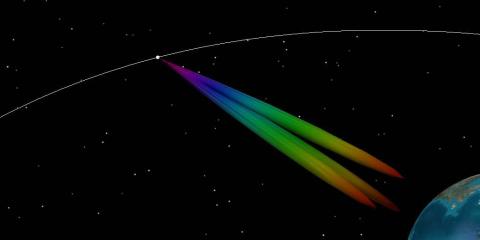
Volume Graphics
The colors of the beam pattern represent gain levels, running the spectrum from red (relatively high gain) to violet (relatively low gain). The size of the beam pattern is determined by the setting for Gain Scale (see above), which specifies the number of kilometers per dB of gain.
Adding back contours and axes
To see a fuller picture of the transmitter, have STK display its contour graphics and axes.
- Return to the MultibeamXmtr's 3D Graphics - Attributes page, select the Show Lines check box in the Contour Graphics section, and click .
- You can also bring the MultibeamXmtr’s body axes back into the picture. Go to the 3D Graphics - Vector page, select the Axes tab, and select the Show check box for Body Axes.
- For better display of the axes, go to the Component section and increase the Scale value to 6.0.
- When you are finished, return to MultibeamXmtr's (
 ) properties (
) properties ( ) and click .
) and click . - When finished, go to the Object Browser and clear the check box next to MultibeamXmtr (
 ).
).
Displaying the receiver volume graphics
- Open CommRcvr's (
 ) properties (
) properties ( ) to the Basic - Definition page.
) to the Basic - Definition page. - In the Model Specs tab, clear the Auto Track check box next to Frequency.
- Change the Frequency value to 2.5 GHz.
- Select the Antenna tab.
- In the Model Specs subtab, make the following changes:
- Click .
- Go to the 3D Graphics - Attributes page.
- In the Volume Graphics section, select the Show Volume check box.
- In the Azimuth section, change the Resolution value to 1 deg.
- In the Elevation section, change the Resolution value to 1 deg.
- Click .
| Option | Value |
|---|---|
| Type | Helix |
| Design Frequency | 2.5 GHz |
| Diameter | 0.1 m |
Viewing in the 3D Graphics window
- Bring the 3D Graphics window to the front.
- Right-click CommSat (
 ) and select Zoom To.
) and select Zoom To. - Use your mouse to manipulate the view so that you have a good view of CommRcvr's Volume Graphics.
- Return to CommRcvr's (
 ) properties (
) properties ( ).
). - On the 3D Graphics - Attributes page, in the Volume Graphics section, select the Show as wireframe check box.
- Click .
- Return to the 3D Graphics window.

Wireframe Mode
This exercise illustrates only a few of the things you can do with antenna beam patterns. Experiment with other Definition settings (such as frequency, antenna model, and antenna size) and graphics options. Observe the results in the 3D Graphics window.
Save your work!
When you are finished, close any properties that are still open and save (![]() ) your scenario.
) your scenario.